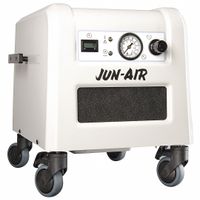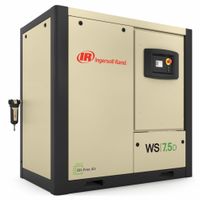Call +(254) 703 030 000 / 751 483 999 / 721 704 777
- Home
- Pneumatics
- Air Compressors Vacuum Pumps Blowers
- Air Compressors
- Electric Air Compressors
.....Read More
Frequently Asked Questions
What is the best electric air compressor for home use?
The best electric air compressor for home use is the California Air Tools 8010. This model is highly regarded for its ultra-quiet operation, producing only 60 decibels of sound, making it ideal for indoor use without causing noise disturbances. It features an 8-gallon steel tank, providing ample air capacity for various home tasks such as inflating tires, powering pneumatic tools, and other DIY projects.
The 8010 is equipped with a powerful 1.0 HP motor that operates at 1680 RPM, reducing wear and extending the compressor's lifespan. Its oil-free dual-piston pump system ensures minimal maintenance and allows for use in a variety of temperatures and uneven terrains. This makes it a versatile choice for homeowners who need a reliable and durable air compressor.
Additionally, the California Air Tools 8010 has a quick recovery time, with a maximum pressure of 120 PSI, ensuring efficient performance for most home applications. It is also lightweight and portable, featuring wheels and a handle for easy transportation around the house or garage.
Overall, the California Air Tools 8010 combines quiet operation, durability, and efficiency, making it the best choice for home use.
How do I choose the right size air compressor for my needs?
1. **Determine Air Requirements**: Identify the tools and equipment you will use with the compressor. Check the manufacturer's specifications for each tool to find the required cubic feet per minute (CFM) and pounds per square inch (PSI).
2. **Calculate Total CFM**: Add up the CFM requirements of all tools you plan to use simultaneously. This will give you the total CFM needed.
3. **Consider PSI Requirements**: Ensure the compressor can deliver the maximum PSI required by your tools. Most tools operate at 90 PSI, but some may need more.
4. **Factor in Duty Cycle**: Consider how often and how long you will use the compressor. A higher duty cycle (e.g., 100%) is necessary for continuous use, while a lower duty cycle (e.g., 50%) is suitable for intermittent use.
5. **Tank Size**: Choose a tank size based on your usage pattern. Larger tanks are better for longer, continuous use, while smaller tanks are suitable for short, intermittent tasks.
6. **Portability**: Decide if you need a portable or stationary compressor. Portable compressors are smaller and easier to move, while stationary ones are larger and more powerful.
7. **Power Source**: Choose between electric or gas-powered compressors. Electric compressors are quieter and require less maintenance, while gas-powered ones are more powerful and suitable for outdoor use.
8. **Budget and Brand**: Consider your budget and research reputable brands known for reliability and customer support.
9. **Future Needs**: Anticipate future projects or tool upgrades that may require more power or capacity.
10. **Consult Experts**: If unsure, consult with a professional or supplier to ensure you select the right compressor for your needs.
What is the difference between a portable and a stationary air compressor?
A portable air compressor is designed for mobility and ease of transport. It typically features a compact design, often with wheels and a handle, allowing it to be easily moved from one location to another. These compressors are generally smaller in size and have a lower capacity, making them suitable for light to medium-duty tasks such as inflating tires, powering small air tools, or for use in home workshops. They are often powered by electricity or gasoline, with electric models being more common for indoor use due to their quieter operation and lack of emissions.
In contrast, a stationary air compressor is designed for permanent installation in a fixed location. These units are typically larger and more powerful, capable of delivering higher air pressure and volume, making them suitable for heavy-duty industrial applications or large-scale workshops. Stationary compressors are often bolted to the floor and connected to a dedicated power source, usually electricity. They can support multiple air tools simultaneously and are ideal for continuous or high-demand operations. Due to their size and power, they often require more maintenance and have a higher initial cost compared to portable models.
In summary, the primary differences between portable and stationary air compressors lie in their mobility, size, power capacity, and intended use. Portable compressors offer convenience and flexibility for smaller tasks, while stationary compressors provide robust performance for demanding applications.
How do rotary screw air compressors work?
Rotary screw air compressors operate using two meshing helical screws, known as rotors, to compress air. The process begins when air enters the compressor through an inlet valve. As the rotors turn, they trap the air between their threads and the compressor casing. The rotation of the screws reduces the volume of the trapped air, thereby increasing its pressure.
The rotors are precisely engineered to ensure minimal clearance between them, which helps in maintaining efficiency and reducing air leakage. As the rotors continue to turn, the compressed air is pushed towards the discharge end of the compressor. During this process, the air is also cooled by an oil injection system, which serves multiple purposes: it lubricates the rotors, seals the gaps to prevent air leakage, and absorbs the heat generated during compression.
Once the air reaches the desired pressure, it exits the compressor through a discharge valve. The oil, now mixed with the compressed air, is separated in an oil separator tank. The separated oil is then cooled and recirculated back into the system, while the clean, compressed air is directed to the storage tank or directly to the point of use.
Rotary screw compressors are favored for their continuous operation capability, high efficiency, and ability to deliver a steady flow of compressed air. They are commonly used in industrial applications where a constant and reliable air supply is essential.
What maintenance is required for electric air compressors?
Maintenance for electric air compressors involves several key tasks to ensure optimal performance and longevity:
1. **Regular Inspection**: Check for any visible damage, leaks, or unusual noises. Inspect hoses and connections for wear and tear.
2. **Air Filter Cleaning/Replacement**: Clean or replace the air filter regularly to prevent dust and debris from entering the compressor, which can reduce efficiency and cause damage.
3. **Oil Level Check**: For oil-lubricated compressors, regularly check and maintain the oil level. Change the oil as per the manufacturer's recommendations to ensure proper lubrication of moving parts.
4. **Drain the Tank**: Regularly drain the moisture from the air tank to prevent rust and corrosion. This is especially important in humid environments.
5. **Check Safety Valves**: Test safety valves to ensure they are functioning correctly. This is crucial for preventing over-pressurization.
6. **Inspect Belts**: For belt-driven models, inspect the belts for wear and tension. Replace any worn or damaged belts to maintain efficiency.
7. **Electrical Components**: Check the electrical connections and wiring for any signs of wear or damage. Ensure that all connections are secure.
8. **Clean Cooling Surfaces**: Keep the cooling fins and surfaces clean to prevent overheating. Dust and debris can accumulate and reduce cooling efficiency.
9. **Check Pressure Settings**: Ensure that the pressure settings are within the recommended range. Incorrect settings can lead to inefficient operation or damage.
10. **Monitor Performance**: Keep an eye on the compressor's performance. Any drop in efficiency or unusual behavior should be addressed promptly.
11. **Professional Servicing**: Schedule regular professional maintenance as recommended by the manufacturer to address any complex issues and ensure comprehensive upkeep.
By adhering to these maintenance tasks, you can ensure that your electric air compressor operates efficiently and has a prolonged service life.
Can electric air compressors be used for inflating car tires?
Yes, electric air compressors can be used for inflating car tires. They are a convenient and efficient tool for this purpose, offering several advantages. Electric air compressors are typically portable, making them easy to store in a garage or even carry in a vehicle for emergencies. They come in various sizes and power capacities, allowing users to choose one that best fits their needs.
When using an electric air compressor for inflating car tires, it is important to ensure that the compressor's pressure output is compatible with the tire's required pressure. Most car tires require a pressure of around 30 to 35 PSI (pounds per square inch), and many electric air compressors can easily achieve this range. Some models come with built-in pressure gauges, allowing users to monitor the pressure and avoid over-inflation.
Electric air compressors are powered by plugging into a standard electrical outlet or a vehicle's 12V power outlet, providing flexibility in different settings. They are generally quieter and more environmentally friendly compared to gas-powered compressors, as they do not emit fumes.
For optimal use, it is advisable to follow the manufacturer's instructions and safety guidelines. Regular maintenance, such as checking hoses and connections for leaks, ensures the compressor operates efficiently. Additionally, using the correct nozzle or adapter is crucial for a secure fit on the tire valve.
In summary, electric air compressors are a practical choice for inflating car tires, offering ease of use, portability, and the ability to quickly achieve the desired tire pressure.
What are the benefits of using a vehicle-mounted air compressor?
The benefits of using a vehicle-mounted air compressor include:
1. **Portability and Convenience**: Vehicle-mounted air compressors are always available on the go, eliminating the need to transport a separate unit. This is particularly useful for remote locations or job sites without power sources.
2. **Space Efficiency**: Mounted directly on the vehicle, these compressors save space, allowing for more room for other tools and equipment.
3. **Time-Saving**: With an air compressor readily available, tasks such as inflating tires, powering pneumatic tools, or cleaning equipment can be performed quickly, reducing downtime.
4. **Versatility**: They can power a wide range of pneumatic tools, including drills, impact wrenches, and nail guns, making them suitable for various applications in construction, automotive repair, and agriculture.
5. **Cost-Effective**: By eliminating the need for multiple compressors or renting equipment, vehicle-mounted compressors can reduce operational costs over time.
6. **Increased Productivity**: Having an air compressor on-site ensures that work can continue without interruption, enhancing overall productivity.
7. **Durability and Reliability**: Designed to withstand harsh conditions, these compressors are built to be robust and reliable, ensuring long-term use with minimal maintenance.
8. **Enhanced Safety**: Properly maintained vehicle-mounted compressors reduce the risk of accidents associated with manual tool operation, as pneumatic tools are generally safer.
9. **Fuel Efficiency**: Many vehicle-mounted compressors are designed to be fuel-efficient, reducing the overall fuel consumption of the vehicle.
10. **Customization**: They can be tailored to specific needs, with options for different power outputs and configurations to suit various industries and applications.





